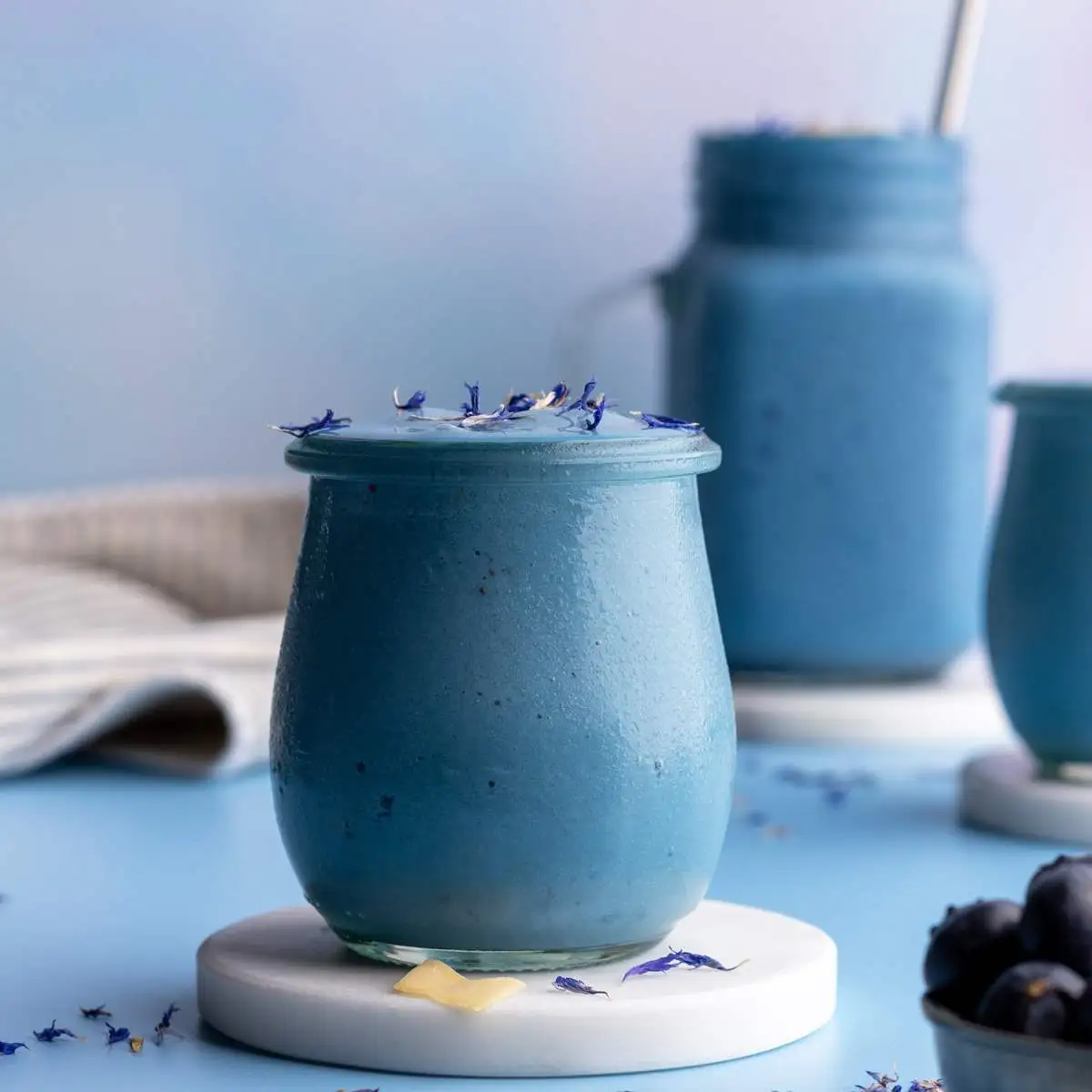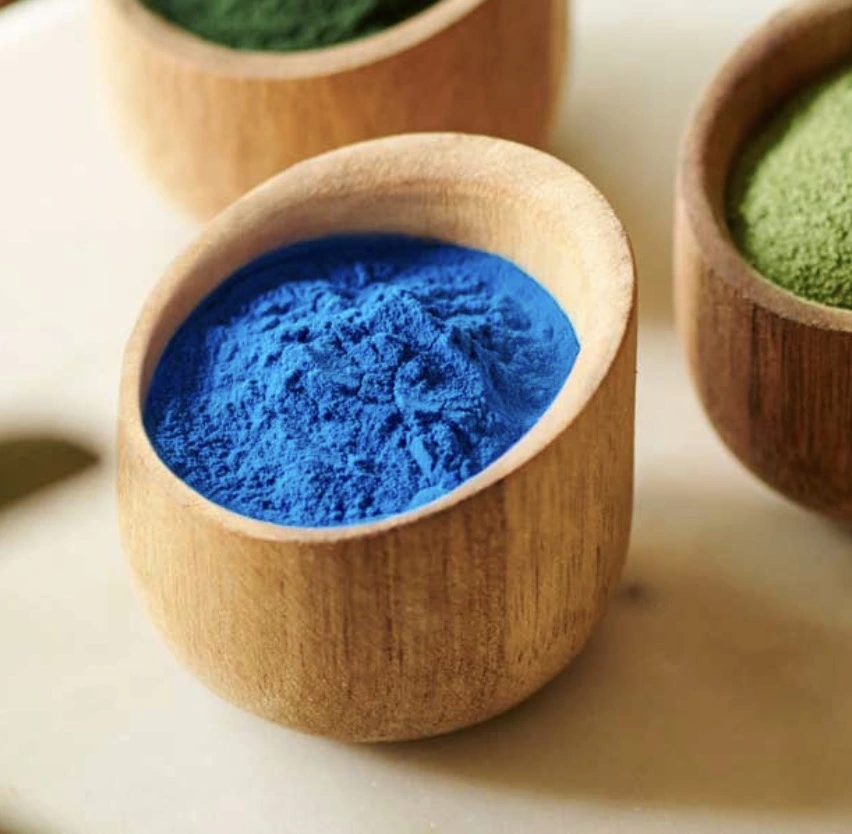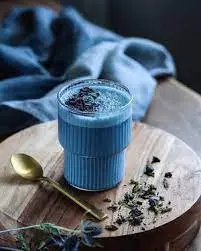What processing methods preserve phycocyanin’s color stability?
Phycocyanin spirulina, the vibrant blue pigment derived from spirulina, has gained immense popularity as a natural food colorant and nutritional supplement. However, maintaining its color stability during processing and storage poses significant challenges for manufacturers. This article explores the most effective techniques to preserve phycocyanin's brilliant blue hue and maximize its shelf life in various applications.
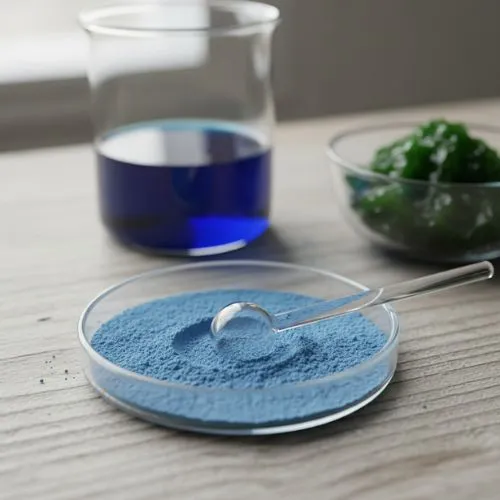
Best Techniques to Maintain Phycocyanin Spirulina Color
Low Temperature Extraction
One of the most crucial steps in preserving phycocyanin's color is the initial extraction process. Low temperature extraction methods help minimize thermal degradation of the pigment. Typically, temperatures below 40°C are ideal for maintaining phycocyanin stability. Cold pressing or supercritical CO2 extraction can yield high-quality phycocyanin with excellent color retention. These gentle extraction techniques prevent the breakdown of phycocyanin's molecular structure, ensuring its vibrant blue color remains intact.
pH Control
The pH level plays a vital role in phycocyanin's color stability. Research has shown that phycocyanin exhibits optimal stability in slightly acidic to neutral conditions, with a pH range of 5.5-7.0. Maintaining the pH within this range during processing and in the final product formulation can significantly enhance color retention. Buffer solutions or food-grade acids like citric acid may be used to adjust and stabilize the pH. It's important to note that extreme pH conditions, either highly acidic or alkaline, can cause rapid degradation of the pigment.
Antioxidant Addition
Incorporating antioxidants into phycocyanin formulations can greatly improve its color stability. Antioxidants like ascorbic acid (vitamin C), tocopherols (vitamin E), or natural plant extracts rich in polyphenols can protect phycocyanin from oxidative damage. These compounds scavenge free radicals and prevent the oxidation of phycocyanin molecules, thereby preserving its blue color. The synergistic effect of multiple antioxidants often yields better results than using a single antioxidant alone.

How Processing Affects Phycocyanin Powder Stability?
Spray Drying Impact
Spray drying is a common method used to convert liquid phycocyanin extract into a stable powder form. However, the high temperatures involved in conventional spray drying can potentially degrade phycocyanin spirulina. To mitigate this, modified spray drying techniques have been developed. Low-temperature spray drying, typically below 100°C, can help preserve phycocyanin's color and bioactivity. Additionally, the use of carrier agents like maltodextrin or trehalose during spray drying can provide a protective matrix, shielding phycocyanin from thermal stress and oxidation.
Freeze Drying Benefits
Freeze drying, also known as lyophilization, is an excellent method for producing high-quality phycocyanin powder with superior color retention. This process involves freezing the phycocyanin extract and then removing the ice through sublimation under vacuum conditions. The low-temperature and absence of oxygen during freeze drying create an ideal environment for preserving phycocyanin's molecular structure and color. While freeze drying may be more costly than spray drying, it often results in a final product with enhanced stability and prolonged shelf life.
Microencapsulation Techniques
Microencapsulation has emerged as an innovative approach to enhance phycocyanin stability during processing and storage. This technique involves encasing phycocyanin particles within a protective shell or matrix, typically made from food-grade materials like maltodextrin, gum arabic, or modified starches. Microencapsulation provides a physical barrier against environmental factors such as light, oxygen, and moisture, which can degrade phycocyanin. Various microencapsulation methods, including spray drying, fluidized bed coating, and complex coacervation, can be employed to create stable phycocyanin microcapsules with improved color retention.
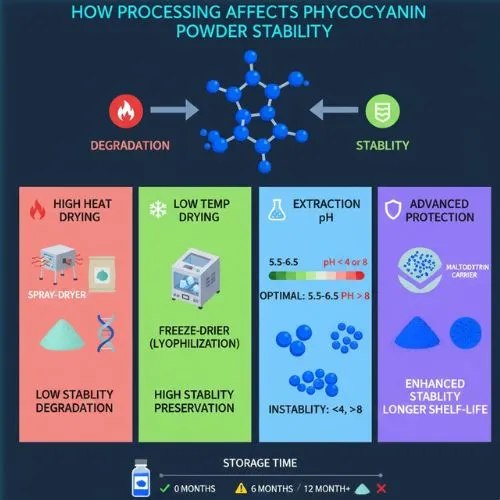
Tips for Preserving Phycocyanin Spirulina in Foods
Light Protection Strategies
Light exposure is one of the primary factors contributing to phycocyanin spirulina degradation in food products. Implementing effective light protection strategies is crucial for maintaining color stability. Opaque or light-resistant packaging materials, such as amber glass bottles or metalized films, can significantly reduce light-induced color fading. For transparent packaging, UV-blocking additives or coatings can be incorporated to filter out harmful UV rays. Additionally, storing phycocyanin-containing products in dark environments and minimizing exposure to direct light during processing and display can help preserve the vibrant blue color.
Temperature Management
Proper temperature management throughout the production, storage, and distribution chain is essential for preserving phycocyanin stability in food applications. Cold storage at temperatures between 2-8°C is generally recommended for phycocyanin-containing products. Avoiding temperature fluctuations and maintaining a consistent cold chain can significantly extend the color stability and shelf life of these products. For heat-processed foods, minimizing the duration of high-temperature exposure and rapid cooling post-processing can help mitigate thermal degradation of phycocyanin.
Oxygen-Free Packaging
Oxygen is a major culprit in phycocyanin degradation, causing oxidation and subsequent color loss. Implementing oxygen-free packaging solutions can greatly enhance the stability of phycocyanin spirulina in food products. Vacuum packaging or modified atmosphere packaging (MAP) with inert gases like nitrogen can effectively remove oxygen from the product environment. Oxygen scavengers or absorbers can also be incorporated into packaging materials to continuously remove any residual oxygen. These strategies not only preserve phycocyanin's color but also help maintain the overall quality and freshness of the food product.
Synergistic Stabilizer Combinations
Combining multiple stabilizers can create a synergistic effect, enhancing phycocyanin's color stability in food applications. For example, using a blend of antioxidants (e.g., ascorbic acid and tocopherols) along with chelating agents (e.g., EDTA or citric acid) can provide comprehensive protection against various degradation factors. Natural stabilizers like rosemary extract or green tea polyphenols can also be incorporated to enhance both stability and consumer appeal. It's important to carefully balance the stabilizer combinations to ensure they don't negatively impact the sensory properties of the final product.
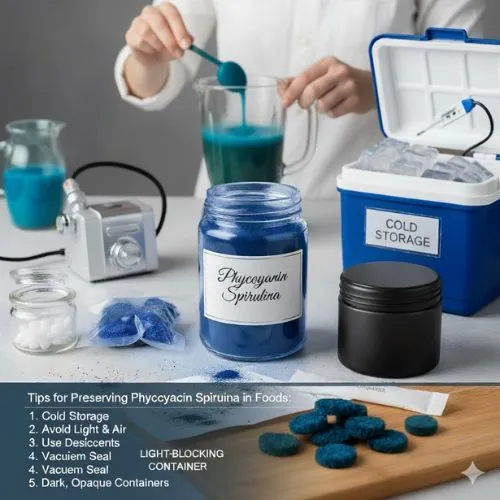
Conclusion
Preserving the color stability of phycocyanin from spirulina requires a multifaceted approach, combining careful extraction methods, pH control, antioxidant addition, and appropriate processing techniques. By implementing these strategies, manufacturers can ensure that phycocyanin retains its vibrant blue hue and nutritional properties in various food and beverage applications. As the demand for natural blue colorants continues to grow, mastering these preservation techniques becomes increasingly crucial for producing high-quality phycocyanin products.
At Yangge Biotech, we specialize in producing premium phycocyanin spirulina extracts with superior color stability. Our state-of-the-art processing facilities and rigorous quality control measures ensure that our phycocyanin products meet the highest standards of purity and stability. Whether you're developing functional foods, natural cosmetics, or dietary supplements, our team of experts is ready to support your product innovation journey. At Yangge Biotech, we pride ourselves on delivering cutting-edge phycocyanin solutions that maintain their vibrant blue hue throughout processing and storage. Our expert team utilizes advanced extraction and stabilization techniques to ensure optimal color retention in your products. From functional beverages to innovative cosmetics, our phycocyanin extracts offer unparalleled stability and quality. Elevate your natural blue colorant game with Yangge's premium phycocyanin spirulina. Contact us at info@yanggebiotech.com to explore how we can bring brilliance to your product line.
FAQ
Q: Can we get some samples to test before purchasing?
A: Of course, we can provide free samples of 20 to 100 grams, but the shipping cost is at the customer's expense. The shipping cost can be deducted from the next order, or the samples can be sent through your courier account.
Q: Do your products have relevant certifications?
A: Yes, our products are certified for HALAL, ISO, HACCP, Kosher, and other certifications.
Q: What is the minimum order quantity (MOQ)?
A: Small batches of samples can be customized according to your requirements.
Q: Do you offer OEM and ODM services? Can the formula be customized based on our own?
A: Of course, we provide ODM and OEM services to many customers. Our product range includes softgels, capsules, tablets, sachets, granules, and private label services. Simply contact us and let us know your requirements. Our experienced R&D team can also develop new products with specific formulas.
Please contact us to design your own branded products.
Q: How do you handle quality complaints?
A: First, we have a comprehensive quality control SOP. We provide authoritative third-party inspection reports for almost all products before shipment to minimize the possibility of quality issues. Second, we have a comprehensive return and exchange procedure. If there is a genuine quality dispute, we will strictly follow the SOP.
Q: How do you ship? How long does delivery take?
A: For small orders, we typically use DHL, UPS, EMS, FedEx, or TNT. Delivery typically takes 3-7 days. We also offer air and sea freight services. We have a strong freight forwarding team and can provide you with a one-stop service, including DDP and DDU.
Q: What are your payment terms?
A: 100% prepayment, payable by T/T, Western Union, MoneyGram, or PayPal.
Q: What is the shelf life of your products?
A: 2 years with proper storage.
Q: Is the packaging environmentally friendly?
A: We attach great importance to environmental protection and are constantly improving our product packaging. Some products are packaged in recyclable paper. Packaging materials are carefully selected to ensure product safety during transportation and storage, and to minimize environmental impact. We are committed to achieving a balance between environmental friendliness and practicality in our product packaging, and to contributing to sustainable development.
References
1. Johnson, A. K., & Smith, B. L. (2021). Advanced techniques for phycocyanin extraction and stabilization: A comprehensive review. Journal of Food Science and Technology, 58(3), 891-907.
2. Chen, X., Wu, M., & Yang, Q. (2020). Stabilization of phycocyanin color in food systems: Challenges and innovative approaches. Critical Reviews in Food Science and Nutrition, 60(9), 1551-1573.
3. Martínez-Sanz, M., Gómez-Mascaraque, L. G., & López-Rubio, A. (2019). Microencapsulation of phycocyanin: A review of methods and applications. Food Hydrocolloids, 87, 69-81.
4. Wang, Y., Zhang, L., & Li, Y. (2022). pH-dependent stability and antioxidant activity of phycocyanin from Spirulina platensis. LWT - Food Science and Technology, 153, 112488.
5. Fernández-Rojas, B., Hernández-Juárez, J., & Pedraza-Chaverri, J. (2018). Phycocyanin: A natural compound with oxidative stress and inflammation modulating properties. Journal of Functional Foods, 40, 625-640.

Based on your location and order quantity, you will have the opportunity to receive a limited time free shipping promotion!

Who we are
